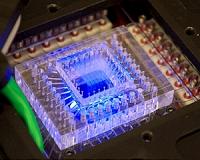 |
Kiel, Germany (SPX) Dec 01, 2010 Thanks to collaborative work between scientists in Donostia-San Sebastian and the University of Kiel (Germany) it has been shown that it is possible to determine and control the number of atoms in contact between a molecule and a metal electrode of copper, at the same time as the electric current passing through the union being recorded. These results were published in the Nature Nanotechnology journal. One of the key problems in nanotechnology is the formation of electrical contacts at an atomic scale. This demands the detailed characterisation of the current flowing through extremely small circuits - so small that their components can be individual atoms or molecules. It is precisely this miniature nature of the system, of typically nanometric dimensions (1 metro = a thousand million nanometers), where the difficulty of this yet unresolved problem arises. In particular, in unions formed by a single molecule, it has been shown that the number of individual atoms making up the contact and their positions are crucial when determining the electric current that is flowing. To date, there has been no experiment where it has been possible to control these parameters with sufficient precision. In the research published by the Nature Nanotechnology journal, however, these scientists have revealed and explained the changes that the electric current flowing through a molecular union (metal/molecule/metal) undergoes, depending on the area of contact uniting the molecule to the metallic electrodes. Basically, changing the number of atoms in contact with the molecule, one by one, it goes from a low state (bad contact) to another, higher one (good contact) of conduction. With bad contact the current is limited by the area of contact, while with good contact the current is limited by the intrinsic properties of the molecule. Taking part in this collaboration project were scientists from the Donostia International Physics Center (DIPC), from the Physics of Materials Centre at the CSIC-University of the Basque Country (UPV/EHU) Mixed Centre and from the Department of the Physics of Materials at the Chemistry Faculty of the UPV/EHU.
Share This Article With Planet Earth
Related Links University of Kiel Computer Chip Architecture, Technology and Manufacture Nano Technology News From SpaceMart.com
 Short Light Pulses Will Enable Ultrafast Data Transfer Within Computer Chips
Short Light Pulses Will Enable Ultrafast Data Transfer Within Computer ChipsSan Diego CA (SPX) Nov 26, 2010 Electrical engineers generated short, powerful light pulses on a chip - an important step toward the optical interconnects that will likely replace the copper wires that carry information between chips within today's computers. University of California, San Diego electrical engineers recently developed the first ultra compact, low power pulse compressor on a silicon chip to be described in ... read more |
|
| The content herein, unless otherwise known to be public domain, are Copyright 1995-2010 - SpaceDaily. AFP and UPI Wire Stories are copyright Agence France-Presse and United Press International. ESA Portal Reports are copyright European Space Agency. All NASA sourced material is public domain. Additional copyrights may apply in whole or part to other bona fide parties. Advertising does not imply endorsement,agreement or approval of any opinions, statements or information provided by SpaceDaily on any Web page published or hosted by SpaceDaily. Privacy Statement |